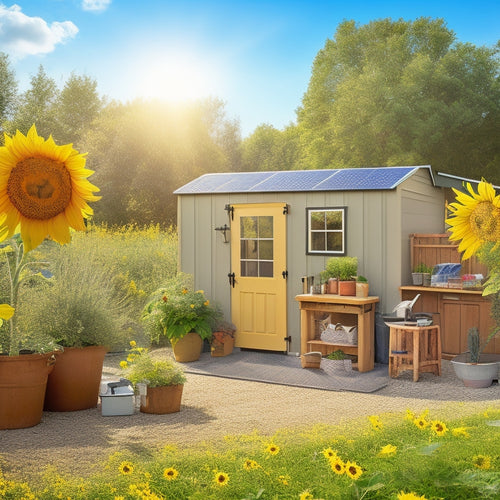
Home Battery Solutions
Share
You're investing in a home battery solution, which means you're taking the first step towards achieving energy independence, reducing your carbon footprint, and ensuring a reliable backup power source during outages. With seamless energy shift, your home's essential systems will remain operational, and you'll enjoy a lower emission footprint. Deep cycle battery technology, wattage, and capacity considerations all play a vital role in selecting the right solution for your needs. By understanding these factors, you'll be able to utilize the full potential of home battery solutions - and as you investigate further, you'll uncover even more ways to optimize your energy management and independence.
The Essentials
- Home battery solutions provide reliable backup power during outages, ensuring critical home systems remain operational.
- Smart integration automatically detects grid outages, seamlessly transitioning to backup power sources.
- Home battery solutions reduce carbon footprint by integrating with renewable energy sources and reducing reliance on fossil fuels.
- Deep cycle battery technology is crucial for home energy storage, with factors like cycle life and deep discharge capability impacting performance.
- Proper assessment of wattage and capacity requirements ensures reliable power supply during outages, balancing power output with energy consumption.
Reliable Backup Power Source
You need a reliable backup power source that can power through outages, ensuring your home remains energized when the grid fails.
A seamless energy shift is vital to minimize disruptions to your daily life. With a home battery solution, you can enjoy uninterrupted power supply during utility outages, keeping your lights on and your appliances running.
This is especially important for households that rely on critical home systems, such as refrigeration and lighting, and essential devices, including life-saving medical equipment and communication systems.
Power Through Outages
When severe weather or grid failures strike, it's vital to have a reliable backup power source to keep your lights on and critical appliances running. You can't control the grid, but you can control your outage preparedness.
With a home battery solution, you're taking the first step towards energy independence. By investing in a backup system, you're guaranteeing your home's resilience during emergency situations.
A Home Battery Backup system provides peace of mind and protection from power outage issues by solving three major problems faced by homeowners, including Power Outage Protection and safeguarding your family's comfort and well-being.
Effective power management is essential during outages. A well-designed backup system prioritizes your vital appliances, such as refrigeration and medical equipment, to minimize disruptions.
Sustainable living is no longer just a concept; it's a reality with energy storage solutions. By storing excess energy generated from your solar panels or grid during the day, you can power your home at night or during outages.
Regular battery maintenance is fundamental to confirm your system operates at peak performance. With a reliable backup power source, you're no longer at the mercy of the grid. You're in control, and that's what energy independence is all about.
Seamless Energy Transition
A grid-down scenario sparks a seamless energy shift with a dependable backup power source, guaranteeing your home's critical systems remain online.
This instantaneous change is made possible by smart integration, which enables your home battery solution to detect grid outages and respond accordingly.
With a dependable backup power source, you can enjoy energy independence, knowing that your essential appliances will continue to function even when the grid fails.
By leveraging Off-Grid Solar technology, you can reduce your reliance on traditional power sources and protect your home from the financial losses and safety risks associated with prolonged power outages.
In the event of an outage, your home battery solution takes over, providing a steady flow of electricity to your home.
This means you can continue to power your refrigerator, lights, and communication devices, guaranteeing your daily life remains uninterrupted.
The smart integration technology guarantees a seamless change, allowing you to enjoy uninterrupted power supply without any manual intervention.
By investing in a dependable backup power source, you're taking a significant step towards energy independence, freeing yourself from the uncertainties of the grid.
With a home battery solution, you can rest assured that your home will remain powered, even when the grid lets you down.
Reduced Carbon Footprint Guaranteed
You're likely aware that traditional energy sources contribute to climate change, but home battery solutions offer a cleaner alternative.
By integrating these systems with renewable energy sources, such as solar panel storage, you'll not only reduce your carbon footprint but also have a reliable backup during power outages.
With the ability to store excess energy generated by solar panels or wind turbines, you'll greatly reduce your reliance on fossil fuels and lower your emissions today.
With a reduced carbon footprint guaranteed, you'll be taking a major step towards a more sustainable future.
Cleaner Energy Options
Cleaner Energy Options (Reduced Carbon Footprint Guaranteed)
You're taking a significant step towards energy independence by considering home battery solutions.
With the increasing focus on renewable energy, you can now utilize the power of solar energy to reduce your reliance on the grid.
Solar integration is an essential aspect of cleaner energy options, allowing you to generate electricity during the day and store it for later use.
This approach not only reduces your carbon footprint but also provides a sense of freedom from traditional energy sources.
Lower Emissions Today
Lower Emissions Today (Reduced Carbon Footprint Guaranteed)
Deep Cycle Battery Technology
You're probably wondering what makes deep cycle batteries so effective for home energy storage.
It's crucial to evaluate the benefits of renewable energy solutions and how they can save you money on energy bills. This technology allows homeowners to power their homes during outages, making it a reliable option.
It all comes down to their cycle life and deep discharge capability. These two factors determine how efficiently your battery can store and release energy over time.
Battery Cycle Life
Battery Cycle Life, a critical aspect of deep cycle battery technology, refers to the number of charge and discharge cycles a battery can withstand before its capacity degrades to a certain level. When you're considering a home battery solution, understanding battery cycle life is essential to get the most out of your investment. Factors affecting battery lifespan include charge and discharge rates, depth of discharge, and operating temperatures. Proper battery maintenance tips, such as avoiding deep discharges and keeping the battery at room temperature, can greatly extend its lifespan.
| Battery Type | Average Cycle Life |
|---|---|
| Flooded Lead-Acid | 200-500 cycles |
| Sealed Lead-Acid | 500-1000 cycles |
| Lithium-Ion | 1000-2000 cycles |
| Nickel-Cadmium | 1000-1500 cycles |
Deep Discharge Capability
Understanding how a battery performs when deeply discharged is vital to getting the most from your home battery solution. You want to know that your battery can handle the demands of your household, even when the grid is down.
Deep discharge capability, also known as deep cycle battery technology, refers to a battery's ability to supply power when deeply discharged, typically below 50% of its capacity.
When choosing a home battery solution, it's essential to evaluate the discharge rates and how they impact battery longevity. A higher discharge rate means the battery can supply more power, but it may reduce its overall lifespan. Conversely, a lower discharge rate may prolong the battery's life, but it mightn't provide enough power to meet your needs.
Look for batteries with a high depth of discharge (DOD) rating, which indicates the percentage of capacity that can be safely used without damaging the battery. A high DOD rating guarantees you can make use of more of the battery's capacity without sacrificing its overall health.
Wattage and Capacity Considerations
You'll need to evaluate the power output of your home battery solution, as it directly impacts the number of appliances you can run simultaneously.
When selecting a home battery system, it's important to assess options like Tesla Powerwall and LG Chem RESU, which offer high-capacity energy storage renewable energy storage solutions.
The storage capacity of your battery, measured in watt-hours (Wh), determines how long it can power your devices.
Power Output Matters
When sizing up a home battery solution, it's essential to evaluate the system's power output, as it directly impacts the number of appliances you can run simultaneously during an outage. You need to take into account the maximum power draw of your essential appliances, such as refrigerators, lights, and medical equipment, to guarantee the battery can handle the load.
A higher power output means you can support more appliances, but it also increases the system's cost and complexity.
Look for a system with high power efficiency to minimize energy losses and maximize your energy independence. Energy management features, such as load balancing and peak shaving, can also help optimize your energy usage and reduce your reliance on the grid.
Additionally, examine battery compatibility with your existing solar integration and home automation systems to create a seamless and cost-effective solution. By choosing a system with low maintenance requirements, you can enjoy grid independence without the hassle of frequent upkeep.
Storage Capacity Needs
Adequate storage capacity is essential to guaranteeing your home battery solution can support your energy needs during extended outages or periods of high demand.
You need to evaluate how much energy you'll need to store to power your essential appliances and devices during an outage. This is where battery sizing comes in. You'll want to determine the total wattage of the devices you want to power and the number of hours you want to power them.
For example, if you want to power a refrigerator, lights, and a computer for 8 hours, you'll need a battery with sufficient capacity to handle that load.
Energy efficiency also plays a vital role in determining your storage capacity needs. The more energy-efficient your appliances and devices, the less energy you'll need to store. This means you can opt for a smaller, more cost-effective battery solution.
Longer Cycle Life Guaranteed
You want a home battery solution that lasts, and that's where advanced battery chemistry comes in.
By leveraging state-of-the-art materials and design, you can enjoy a notably longer cycle life, reducing the need for frequent replacements and minimizing maintenance costs.
With advanced battery chemistry, you can rest assured that your home battery will provide reliable power for years to come.
Advanced Battery Chemistry
Lithium-ion batteries, the cornerstone of home battery solutions, have undergone a significant evolution with the advent of advanced battery chemistry. You're now benefiting from innovations that have changed the industry.
Lithium innovation has led to significant improvements in energy density, enabling you to store more power in smaller, more efficient packages. Electrolyte advancements have also enhanced thermal stability, ensuring your battery operates safely within ideal temperatures.
As you consider advanced battery chemistry, you'll appreciate the focus on cost efficiency, recycling processes, and safety features. Charging technology has become more efficient, reducing the time it takes to replenish your battery.
Scalability options have also expanded, allowing you to customize your energy storage to meet your unique needs. With advanced battery chemistry, you can monitor performance metrics in real-time, giving you greater control over your energy usage.
Frequently Asked Questions
Can I Use a Home Battery With My Existing Solar Panel System?
You can definitely use a home battery with your existing solar panel system if it's compatible; check the inverter's solar integration capabilities and verify the battery's compatibility with your system's voltage and power output to make it work seamlessly.
How Long Does It Take to Install a Home Battery Solution?
When you decide to add a battery to your existing solar setup, you'll want to know the installation timeline. Typically, the installation process takes a few hours to a few days, depending on the complexity of the job and the installer's skill.
Are Home Batteries Safe From Overheating and Electrical Fires?
You'll be relieved to know that reputable manufacturers design their batteries with overheating prevention and fire safety in mind, incorporating features like thermal management systems, firewalls, and advanced monitoring to minimize risks and guarantee your safety and freedom.
Can I Monitor My Home Battery's Performance Remotely?
You're the captain of your energy ship, steering towards freedom. With remote monitoring, you can chart your course, tracking your battery's performance in real-time, receiving alerts and understandings to optimize its efficiency, and making data-driven decisions to maximize your energy independence.
Are There Any Government Incentives for Home Battery Solutions?
You can tap into federal rebates and state incentives for energy storage, which may cover a significant portion of your home battery solution's cost, giving you financial freedom and peace of mind.
Final Thoughts
With a home battery solution, you're the captain of your energy destiny. Like a skipper steering a ship through calm and stormy seas, you'll maneuver power outages and grid fluctuations with confidence. With reliable backup power, reduced carbon footprint, and advanced deep cycle battery technology, you'll ride the waves of uncertainty, always staying afloat. Longer cycle life means fewer replacements, and with wattage and capacity considerations in mind, you'll chart a course towards energy independence.
Related Posts
-

Building an Emergency Backup Solar Power System in 5 Essential Steps
Building an emergency backup solar power system involves five key steps. First, assess your daily energy needs to ide...
-

Top Camping Water Bottles for Adventure
When you're out adventuring, picking the right camping water bottle is essential for staying hydrated. Look for durab...
-

Replacing Old Appliances With Sustainable Alternatives
Replacing old appliances with sustainable alternatives can change your home into an energy-efficient space. Not only ...


